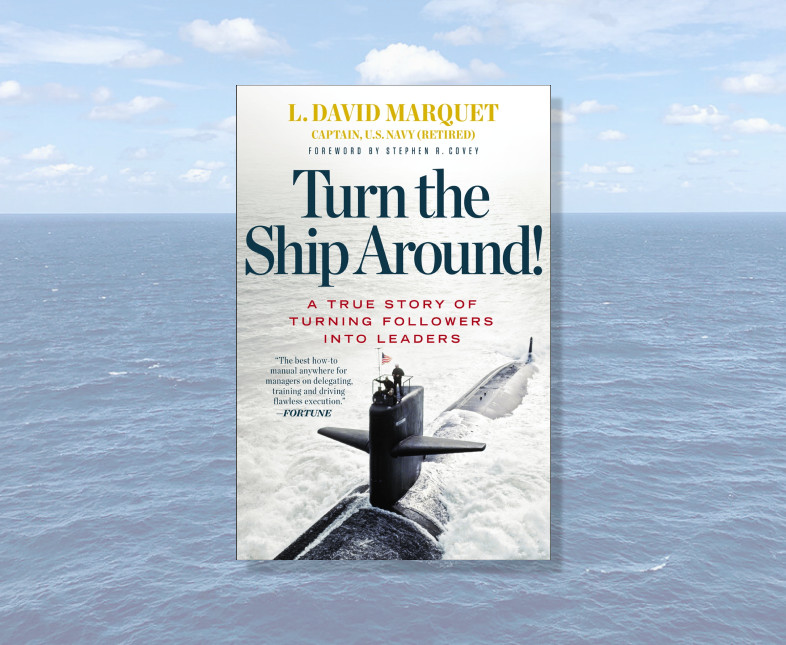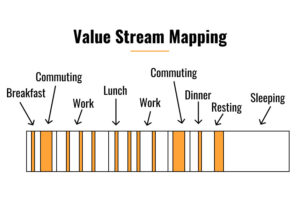PART I – STARTING OVER
1 | Pain
As an engineer officer in the USS Will Rogers in 1989, David Marquet wanted to empower his crew but failed.
The Will Rogers is a nuclear-powered ballistic missile submarine built during the Cold War against the Soviet threat.
During his service on the Sunfish, he felt empowered and he wanted to pass this kind of leadership to the crew on the Will Rogers.
After observing the captain on another submarine dashing everywhere and giving orders, he knew that he was not physically able to do the same and he was certain that it was clearly not the kind of leadership he wanted.
Back on the Will Rogers, he gave broad guidance instead of a list of tasks and expected the crew to figure it out but it failed.
They fell behind schedule and several errors required rework.
The crew was not used to this kind of leadership and preferred someone to tell them what to do.
This test was a bad experience, the crew made critical mistakes and David Marquet found himself giving orders and controlling all the steps to be sure that everything would be done on schedule.
His efforts at empowering his team failed.
He felt exhausted and miserable.
The three years at the Will Rogers taught him three lessons:
- Empowerment is not external but comes from within. When your boss empowers you, it feels like manipulation.
- Traditionally, management tells the subordinates what to do but he notices he was at his best when he had specific goals but a broad latitude in accomplishing them.
- On a submarine, competence seems to follow the captain. When a good captain is leading, the crew performs well, but when a new captain makes a mistake, the crew just follows. Competence should run throughout the entire organization.
2 | Business as Usual
David Marquet was going to be the captain of the USS Olympia and he had one year to get ready.
He studied all the equipment configurations, technical plans, and the biography of each officer.
To be fully prepared, getting on board was the opportunity to see the ship and the crew operating at sea before taking command.
But this occasion had been denied by the current captain who ignored him.
In the traditional leadership, the captain is responsible for the performance of his crew during the duration of his tenure, not a day longer.
Having one more person on board would have been an inconvenience and he had no interest in facilitating Marquet’s integration.
The captain was thinking short-term and didn’t care about the future performance of his crew after he left.
The leadership is top-down, the crew is trained to obey the captain, not to think.
The subordinates like this kind of management because it removes their responsibility and the hard work of thinking.
A vast untapped human potential is lost because they are treated as followers.
Changing this kind of mentality was going to meet resistance, the improvement was going to be incremental and not radical.
In December 1998, in Pearl Harbor, David Marquet received an unexpected and sudden phone call, his command of the Olympia was canceled, he was going to command the Santa Fe just after New Year’s.
All his preparation was for the wrong submarine.
3 | Change of Course
He had six months to get ready to command the Santa Fe.
The Santa Fe had a bad reputation, it had the worst retention in the submarine force and had regular delays to get ready on time.
The Santa Fe was lacking leadership, but he was ready for the challenge.
He was not going to fire anyone, he wanted to send a message to the crew that the problem was not them but the management.
Soon after, he noticed that the twelve chiefs (middle management) were qualified but were unempowered and uninspired. They are key to be sure that things are done right.
The priority was going to change their behaviors, and how the crew acts and interacts.
It was the perfect opportunity for David Marquet to implement a new kind of leadership, the one he wanted, empowering the crew and avoiding the top-down approach.
4 | Frustration
The first thing he noticed when he descended the hatch and walked the passageways is that the crew was avoiding eye contact with him, they had low morale.
As he was not familiar with this submarine, he started wandering and asked questions to learn more about the Santa Fe.
Usually, the captain asks questions, not out of curiosity but to make sure they knew the equipment.
The questions he asked were genuine, he really wanted to learn what was going on in the Santa Fe, what were the problems, and what they should do to improve. The crew clearly knew what were the problems:
- “Admin disappears into a black hole.”
- “The junior officers are the source of low standards.”
- “I was promised a certain job when I came here, and it hasn’t happened.”
- “I just keep my head down and try to stay out of trouble.”
Building trust with this demoralized was the priority.
5 | Call to Action
The Department head meeting started late, attendees were waiting for someone else. Only when everyone arrived that the captain would be invited.
Lack of punctuality is a signal of a bigger problem.
The lieutenant Dave Adams was the weapons officer, he had ideas for improving his department but each project fell on deaf ears, someone up the chain of command ignored his ideas so nothing happened, he was clearly frustrated.
A junior sailor applied for leave for Christmas weeks earlier but didn’t get approval yet. According to the process, seven people in the chain of command had to sign the leave chit. It was the system, not the people, that failed.
During the morning formation on the pier, the captain was making a speech, as the crew was standing behind their chiefs and officers in a square, they could not hear a thing and nobody cared. The crew knew that if something was important, their chief would repeat it to them during another meeting.
With a leader-follower mindset, it didn’t matter.
Their potential and talents were wasted. Their pain and frustration were providing David Marquet with a tremendous call to action.
6 | “Whatever They Tell Me to Do!”
With the “whatever they tell me to do” mindset, the followers had their brains shut off. Only the Executive Officer (XO) and department heads were doing the thinking.
With 135 men on board, only 5 of them were using their thinking capacity (observe, analyze, and problem-solve).
The captain is responsible for the lives of the crew, if he delegates his responsibility to the other officers and something goes wrong, it is his career and the lives of his crew that are at stake.
That’s probably why delegating responsibility is so difficult.
All the structure was built around the idea of leader-follower, everything reinforced that the guys at the top were the leaders and the rest of the crew were the followers.
The result was the lack of initiative from the sailors waiting for orders and the department heads’ paralysis without the captain.
7 | “I Relieve You!”
January 8th, 1999 was the big day, David Marquet was going to relieve the captain and become the new captain of the Santa Fe.
According to the U.S. Navy Regulations, the captain has absolute responsibility for whatever happens on his ship. Therefore, each captain has an incentive to maximize performance during his tour and his tour only.
There is no incentive for maximizing the performance of the crew after the captain was relieved.
Revealing the mistakes is the first step toward excellence.
Open and honest discussions help evaluate the mistakes and find ways to improve.
However, the Santa Fe culture was avoiding making mistakes. The best way not to make mistake is not to do anything or make any decisions. A common joke on Santa Fe was “Your reward is no punishment”.
By focusing on excellence, the reduction of mistakes is going to be a positive side effect and not the goal.
Why did they sail on a submarine? He reminded the “why” during his speech, his purpose was to serve the country.
PART II CONTROL
8 | Change, in a Word
The change was going to come from the middle.
If he started from the XO or department heads, he would repeat the top-down leader-follower approach that he wanted to avoid. If he started from the bottom with the junior officers and junior enlisted men, there was going to have too much distance between them and him, he could not support them.
The approach was to change the behaviors instead of changing the mindset.
The chiefs knew that they were going to be accountable and responsible, that they could not hide behind their leader anymore. They agreed that they would become responsible for the performance of their divisions and all that encompassed.
To show that the captain was walking the walk, he immediately made the change in the manual. He had moved a significant amount of the Executive Office’s authority to the chiefs.
The two main reasons leaders are reluctant to delegate their authority are the issue of clarity and the issue of competence.
Does the person understand the goal the organization is trying to accomplish? Does he have the competence to make good decisions?
9 | “Welcome Aboard Santa Fe!”
D-169 before deployment, they had 169 days to be ready to go on missions. Several inspections were scheduled and conducted by the Commodore Mark Kenny. Mark Kenny and his staff were going to ride the Santa Fe for four days and observe the operations.
The crew was excited and skeptical at the same time. There was the hope of doing things better but it was totally new for them, and they were the only ones in the Navy doing this way.
The new captain was committed to doing whatever he thought was best for the Santa Fe.
One of the new rules was they had to greet a visitor by saying the visitor’s name, their own name, and the ship’s name. The idea was to make them proud to serve in the Santa Fe.
To announce this rule, he gathered everyone not in a square but in a circle around him and put the chiefs and officers at the back so every sailor can hear him.
You have two approaches to change the behaviors: change the thinking then hope for a change in the behaviors, or change the behavior and hope this leads to new thinking. He chose the latter.
Acting your way to new thinking is a mechanism for control.
10 | Under Way on Nuclear Power
Nautical charts serve as maps to guide submarine operations, they need to be up-to-date, then assigned water is laid out so the submarine can move without fear of collisions, and finally, the courses, speeds, and depth zones are added to the map.
The map the navigator prepared for the operations in the Maui basin was perfect but irrelevant.
The route he chose was effectively leading to the Maui basin but it was not the route the potential enemy would take. The purpose was to practice in a real situation, not going from point A to point B.
Having a short discussion between the captain and the navigator would have avoided this mistake, but as the subordinates were afraid of mistakes and wanted to show a perfect map, they missed the purpose and wasted their effort.
Another issue is that the maps were inconsistently drawn. The same color had different meanings. The quartermaster who drew the map explained he used the markers available at the time. They agreed to add a standard for colors in their new procedures so the colors would be consistent.
11 |“I Intend To…”
EPM “ahead two thirds” the captain ordered, and the Officer of the Deck (OOD) repeated the order EPM “ahead two thirds” but after a few seconds, nothing happened.
The helmsman should have increased the speed of the auxiliary electric motor to two-thirds of its capacity, after a short while he reported: “Captain, there is no ahead two-thirds on the EPM!”
The OOD knew there were not two-thirds but repeated the order because the captain told him to.
This kind of mistake happens when there is a leader-follower mindset. The crew was trained to obey, not to think. If the captain was wrong, the whole crew would follow him in the mistake.
In order to avoid this mistake, David Marquet promised himself not to give any orders anymore.
Each member has to state their intentions with “I intend to …” and he would validate.
By switching their way of communicating from passive followers to proactive, the 134 men would be engaged and committed.
Expressing their thought helped to outline the rationale for what they were about to do.
To create more leaders, the captain gave control to his officers.
12 | Up Scope!







